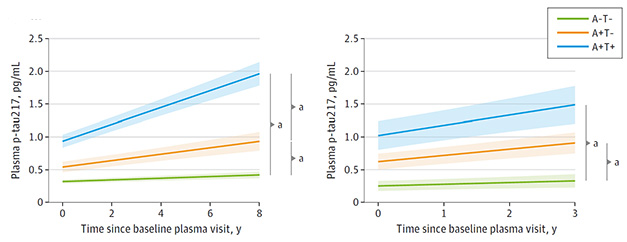Paper Alert: p-Tau217 Blood Test Predicts Plaques, Tangles Over Time
Quick Links
Researchers led by Nicholas Ashton at the University of Gothenburg, Sweden, recently reported that ALZpath Inc.’s plasma phospho-tau217 assay detected amyloid and tau positivity with 92 to 97 percent accuracy. Now, the data is peer-reviewed and out in the January 22 JAMA Neurology. The assay also picked up an annual rise in plasma p-tau217 only in amyloid-positive people, with the steepest increase in those with tangles, too. Alzforum previously covered this work (Dec 2023 conference coverage).
Ashton and colleagues compared amyloid and tau PET scans to blood and CSF samples from 786 participants across three cohorts: Montreal's Translational Biomarkers in Aging and Dementia (TRIAD), the Wisconsin Registry for Alzheimer’s Prevention (WRAP), and Barcelona's Sant Pau Initiative on Neurodegeneration (SPIN). Participants' average age was 66 years; two-thirds were women. PET determined amyloid and tau positivity in TRIAD and WRAP, while CSF Aβ42/40 and p-tau181 did so in SPIN.
The scientists evaluated the ALZpath p-tau217 blood test, an immunoassay that uses proprietary antibodies with the highly sensitive single molecular array (Simoa) platform. Plasma p-tau 217 measured with this assay distinguished amyloid-positive participants from those without plaques with areas under the curve of 0.92 to 0.96 across the three cohorts. AUC measures specificity and sensitivity, with 1 being perfect. The assay was similarly accurate in detecting tau pathology, with AUCs of 0.93 to 0.97.
Longitudinal change in plasma p-tau217 also predicted who had plaques and tangles. While plasma p-tau217 stayed steady over eight years of follow-up in people with no AD pathology, it ticked up year-over-year in amyloid-positive participants and even faster in those positive for neurofibrillary tangles (image below).

Faster Rise with Plaques, Tangles. In people with plaques and tangles as per PET (blue), plasma p-tau217 rose fastest, followed by those with plaques but no tangles (orange) and people without AD pathology (green). Data from the WRAP (left) and TRIAD (right) cohorts. [Courtesy of Ashton et al., JAMA Neurology, 2024.]
ALZpath’s plasma p-tau217 assay is commercially available for research use from Quanterix, a diagnostic company in Billerica, Massachusetts. According to Andreas Jeromin of ALZpath, the test will be offered through the CLIA-certified lab NeuroCode, based in Bellingham, Washington, in the coming weeks; other CLIA-certified labs across the U.S. will be added later this year. It will be sold to all clinicians to add to their cognitive decline assessment tool kit.
The test is still a ways away from being formally approved as an-vitro diagnostic (IVD) in routine care. “We are launching a number of prospective real-world studies in U.S. and European primary care and memory clinics this year, with the initial studies starting enrollment in the first quarter,” Jeromin told Alzforum. He said ALZpath plans to file for FDA approval in the future but did not say when.—Chelsea Weidman Burke
References
News Citations
External Citations
Further Reading
No Available Further Reading
Primary Papers
- Ashton NJ, Brum WS, Di Molfetta G, Benedet AL, Arslan B, Jonaitis E, Langhough RE, Cody K, Wilson R, Carlsson CM, Vanmechelen E, Montoliu-Gaya L, Lantero-Rodriguez J, Rahmouni N, Tissot C, Stevenson J, Servaes S, Therriault J, Pascoal T, Lleó A, Alcolea D, Fortea J, Rosa-Neto P, Johnson S, Jeromin A, Blennow K, Zetterberg H. Diagnostic Accuracy of a Plasma Phosphorylated Tau 217 Immunoassay for Alzheimer Disease Pathology. JAMA Neurol. 2024 Mar 1;81(3):255-263. PubMed.
Annotate
To make an annotation you must Login or Register.

Comments
No Available Comments
Make a Comment
To make a comment you must login or register.